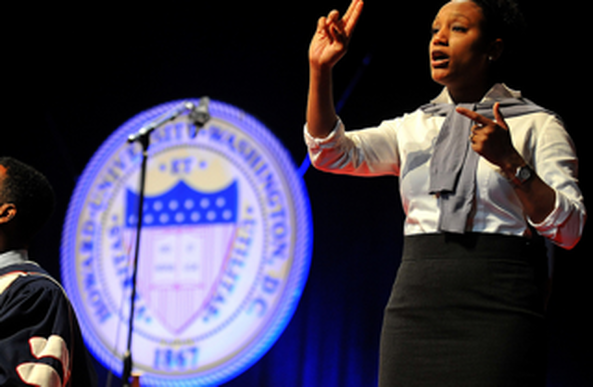|
DLisa Robinson, founder of Accessible Integrated Media, is shown interpreting at an event held at Howard University. When I was asked to reprise a presentation of my talk, Measures of Center for NCTM, I was not aware that I would be asked to record it. Doing so demands the added responsibility of being prepared early (I am a chronic procrastinator), and is without the benefit of immediate feedback. In this presentation, I talk about the importance of centering students who tend to get marginalized and share personal experiences and observations. However, in the three years since presenting it at Twitter Math Camp, I have realized I have a long way to go in decentering self. I tend to think I am doing the thing, until something jars me into the reality that I am not. I remember when I began using pronouns in my email signatures and screens. But the real work lies in normalizing gender fluidity in everyday speech, interactions with friends, and in my classroom. I also remember when I finally felt that my land acknowledgement was good...until a new perspective and critical feedback told me it was lacking. And, yes, I now enable autocaptioning in Powerpoint to make my words accessible to the deaf community and thought this was good enough. Well, it's not. It's just a start. As I wrestled with the approaching deadline to create and record, I decided to have the recording captioned by a human and include an interpreter. I write this piece because I am finally realizing that this isn't an add-on. It is absolutely necessary for accessibility and should be normalized. I have learned so much from my friend, Lara Metcalf, who tirelessly fights for conference accessibility for the deaf community. She made me realize that the accuracy of autocaptioning in Powerpoint is frustratingly lacking. I turned to my friend, DLisa Robinson (pictured above) to provide the services through one of her companies. I'd like to share with you what I learned from the experience. Live Signing I sent DLisa the text of my speech prior to recording. That allowed her to ask about metaphors and homophones and nuances in word meaning. This would never have occurred to me, but context matters. It would have also been the time to make sure that any specialized content words were discussed. Depending on the length of the presentation, multiple signers may be needed to maximize the accuracy of the message. Since my session is 45 minutes, one signer is adequate, but two would have been better. I also wished I would have enlarged the video of the signer. Next time. Slides A deaf person will either rely on signing or captioning, but not both. The same can be said for the text on the slide and the text in the captioning - both will not be read. This was another eye-opener. I have gotten into the habit of not reading words on a slide. I thought that was condescending to an audience. But if I want them read and I also want the captioning read, I need to pause for both to occur. Similarly, if I want the words on my slide to be signed, I will have to actually read them. For me, this will change the way I design slides and use my voice.
More and more, these practices are becoming more normalized. DLisa's services were used at the MIT Teaching Systems Lab's Future of Math Professional Learning Conference held in January, 2021. Says Chris Buttimer, a post-doctoral associate there: "We are thrilled to be able to offer critical accommodations that help all participants meaningfully engage in our upcoming virtual conference, The Future of Math Professional Learning. We look forward to collaborating with D’Lisa Robinson and colleagues to realize this goal.”
2 Comments
2/1/2021 06:11:44 am
Thanks for unpacking this and for shining a light on both what's been done and what we still have to do around making our presentations more accessible.
Reply
Marian Dingle
2/1/2021 06:22:11 am
Yes! Just when we think we have arrived, we realize there is much more to think about. It is a huge wake up call that I do not have deaf friends. I need to change that.
Reply
Your comment will be posted after it is approved.
Leave a Reply. |
My WhyReflecting is good for the soul. Doing so in public is terrifying and exhilarating. Archives
April 2021
Categories |

 RSS Feed
RSS Feed